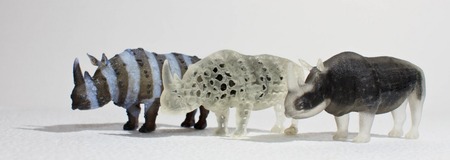Developed by MIT and presented at this year’s SIGGRAPH conference, OpenFab proposes a way to more easily produce incredibly complex milt-material objects.
OpenFab is not a 3D printer; it is a software “pipeline” of steps that enable the creation of complex, multi-material 3D models that can then be printed on a 3D printer capable of mixing materials during printing.
At this time, only Stratasys/Objet has the technology to mix materials with their patented PolyJet process. It permits two different materials to be mixed on the fly in up to 13 different mix ratios. However, it’s very likely future 3D printers will be able to mix more than two materials.
And that’s where things get complicated. How do you handle models that involve mixed materials? Did you ever wonder why PolyJet sample prints usually have only one or two mixes of materials on only a couple sections of the model? There’s a reason why. The MIT team identified these challenges:
- Poor specification methods
- Lack of scalable software architectures
- Giga- and Tera- voxels per volume
- Continuous gradation between materials
- Reusable material definitions
- Resolution and printer independence
Imagine a 3D print of an organic object that includes numerous hard and soft areas, flexible joints, internal stress-carrying features, with multiple textures and colors, all flowing seamlessly and gradually throughout the entire model. How would you go about producing such a 3D model? You can’t.
It sounds difficult to solve, and it is. Nevertheless, OpenFab describes a multi-step process for handling these issues to produce multi-material 3D models.
Obviously, this is research work and you can’t make much use of this today. However, we believe this research will lead to a vastly more powerful 3D printing world in the future.
Via MIT


